Unit 5: Management Accounting Systems & Techniques Report (2020-21)
VerifiedAdded on 2023/01/03
|7
|2610
|20
Report
AI Summary
This report addresses a management accounting assignment for a Trainee Management Accountant role, focusing on a consultancy firm and its client, Capital Joinery Ltd. It covers the application of management accounting systems and techniques, including cost-volume-profit analysis, budgetary control, and various costing methods. The report evaluates management accounting systems, reporting methods, and planning tools, including their advantages and disadvantages. It further explores the application of these tools for budget preparation, forecasting, and solving financial problems, with an emphasis on achieving sustainable success. The report also includes the calculation of costs using marginal and absorption costing techniques, the preparation of profit statements, and the analysis of material variances and inventory accounting methods (LIFO and average cost). Finally, the report interprets financial data for a range of business activities.
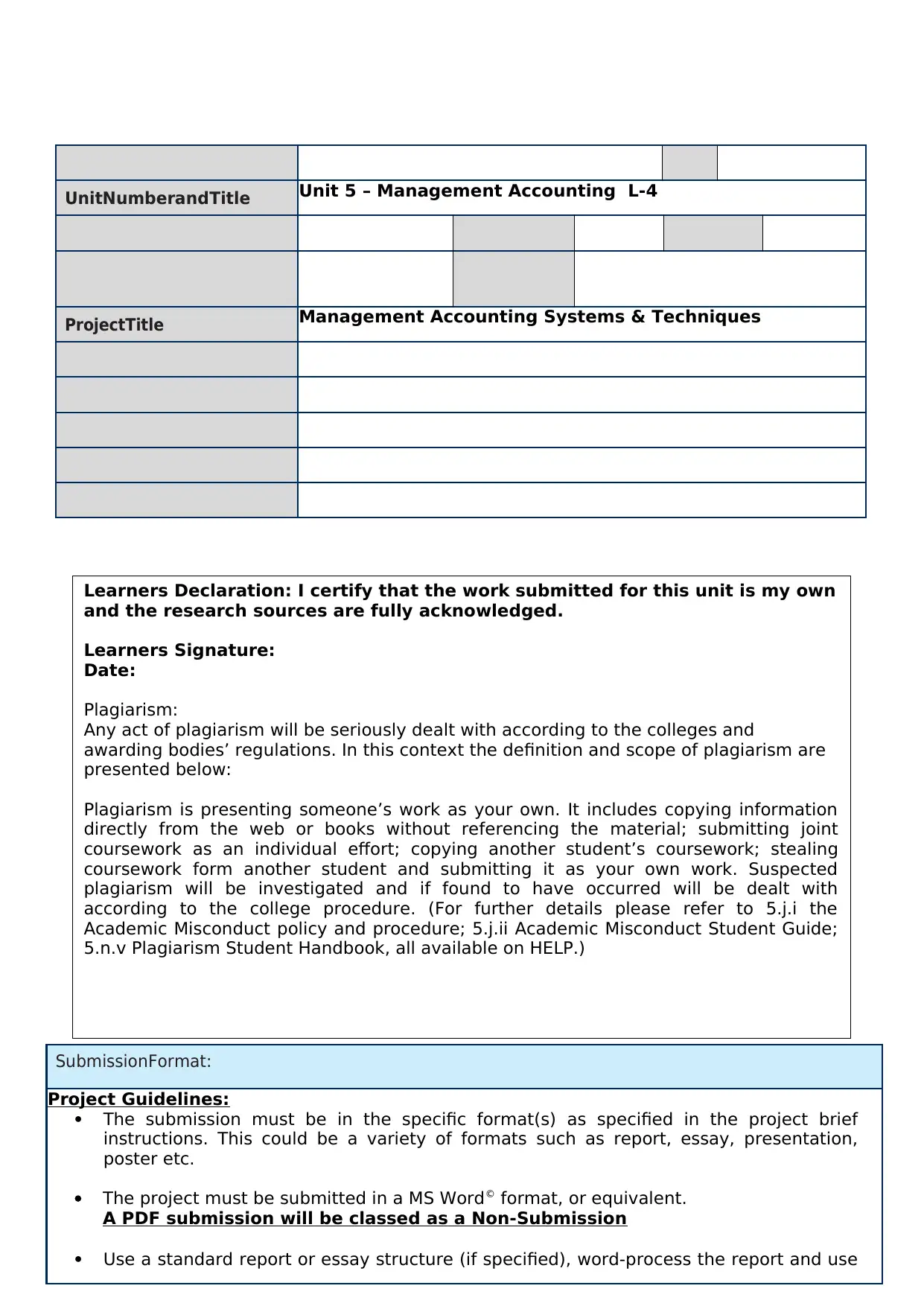
UnitNumberandTitle Unit 5 – Management Accounting L-4
ProjectTitle Management Accounting Systems & Techniques
SubmissionFormat:
Project Guidelines:
The submission must be in the specific format(s) as specified in the project brief
instructions. This could be a variety of formats such as report, essay, presentation,
poster etc.
The project must be submitted in a MS Word© format, or equivalent.
A PDF submission will be classed as a Non-Submission
Use a standard report or essay structure (if specified), word-process the report and use
Learners Declaration: I certify that the work submitted for this unit is my own
and the research sources are fully acknowledged.
Learners Signature:
Date:
Plagiarism:
Any act of plagiarism will be seriously dealt with according to the colleges and
awarding bodies’ regulations. In this context the definition and scope of plagiarism are
presented below:
Plagiarism is presenting someone’s work as your own. It includes copying information
directly from the web or books without referencing the material; submitting joint
coursework as an individual effort; copying another student’s coursework; stealing
coursework form another student and submitting it as your own work. Suspected
plagiarism will be investigated and if found to have occurred will be dealt with
according to the college procedure. (For further details please refer to 5.j.i the
Academic Misconduct policy and procedure; 5.j.ii Academic Misconduct Student Guide;
5.n.v Plagiarism Student Handbook, all available on HELP.)
ProjectTitle Management Accounting Systems & Techniques
SubmissionFormat:
Project Guidelines:
The submission must be in the specific format(s) as specified in the project brief
instructions. This could be a variety of formats such as report, essay, presentation,
poster etc.
The project must be submitted in a MS Word© format, or equivalent.
A PDF submission will be classed as a Non-Submission
Use a standard report or essay structure (if specified), word-process the report and use
Learners Declaration: I certify that the work submitted for this unit is my own
and the research sources are fully acknowledged.
Learners Signature:
Date:
Plagiarism:
Any act of plagiarism will be seriously dealt with according to the colleges and
awarding bodies’ regulations. In this context the definition and scope of plagiarism are
presented below:
Plagiarism is presenting someone’s work as your own. It includes copying information
directly from the web or books without referencing the material; submitting joint
coursework as an individual effort; copying another student’s coursework; stealing
coursework form another student and submitting it as your own work. Suspected
plagiarism will be investigated and if found to have occurred will be dealt with
according to the college procedure. (For further details please refer to 5.j.i the
Academic Misconduct policy and procedure; 5.j.ii Academic Misconduct Student Guide;
5.n.v Plagiarism Student Handbook, all available on HELP.)
Paraphrase This Document
Need a fresh take? Get an instant paraphrase of this document with our AI Paraphraser
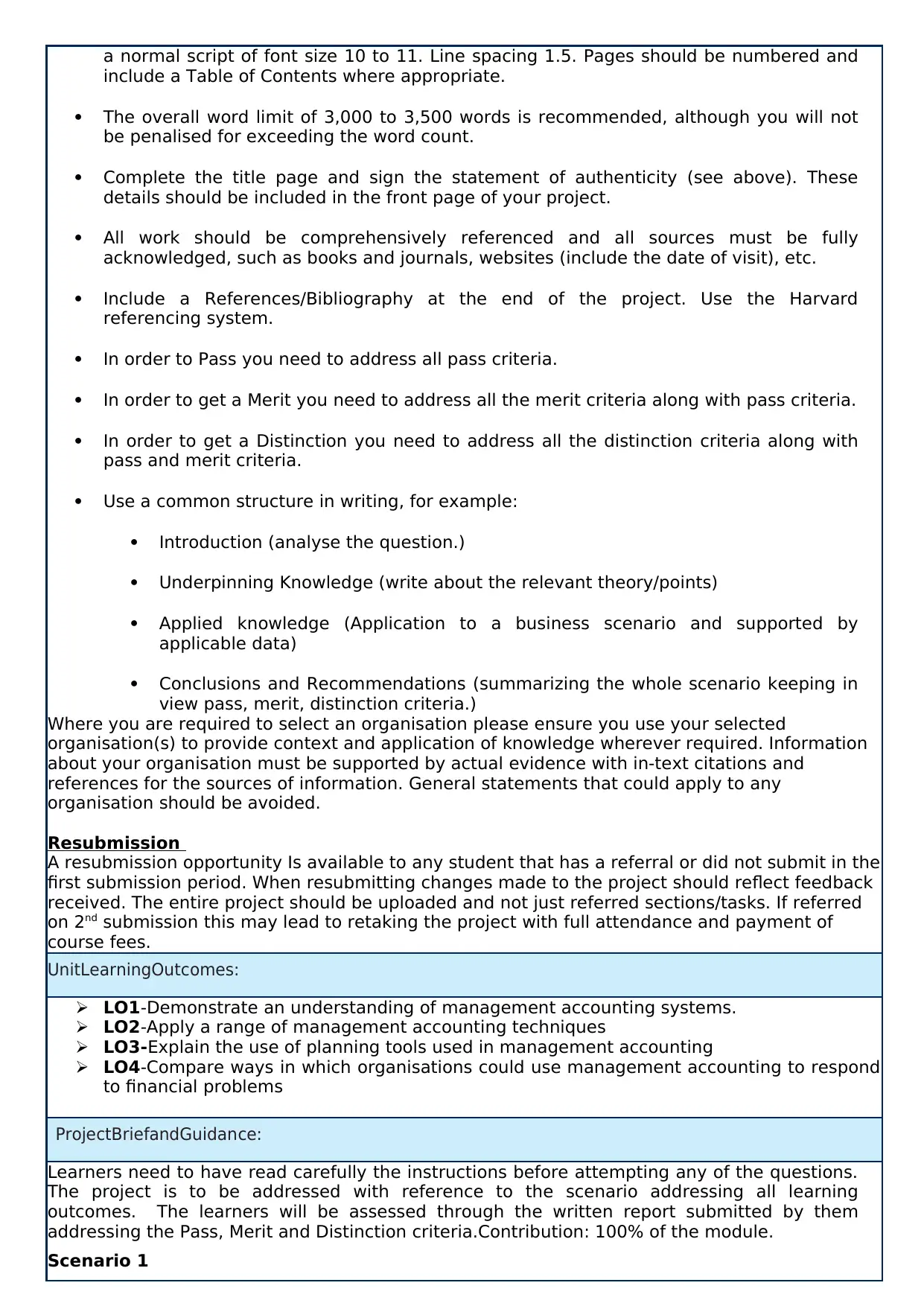
a normal script of font size 10 to 11. Line spacing 1.5. Pages should be numbered and
include a Table of Contents where appropriate.
The overall word limit of 3,000 to 3,500 words is recommended, although you will not
be penalised for exceeding the word count.
Complete the title page and sign the statement of authenticity (see above). These
details should be included in the front page of your project.
All work should be comprehensively referenced and all sources must be fully
acknowledged, such as books and journals, websites (include the date of visit), etc.
Include a References/Bibliography at the end of the project. Use the Harvard
referencing system.
In order to Pass you need to address all pass criteria.
In order to get a Merit you need to address all the merit criteria along with pass criteria.
In order to get a Distinction you need to address all the distinction criteria along with
pass and merit criteria.
Use a common structure in writing, for example:
Introduction (analyse the question.)
Underpinning Knowledge (write about the relevant theory/points)
Applied knowledge (Application to a business scenario and supported by
applicable data)
Conclusions and Recommendations (summarizing the whole scenario keeping in
view pass, merit, distinction criteria.)
Where you are required to select an organisation please ensure you use your selected
organisation(s) to provide context and application of knowledge wherever required. Information
about your organisation must be supported by actual evidence with in-text citations and
references for the sources of information. General statements that could apply to any
organisation should be avoided.
Resubmission
A resubmission opportunity Is available to any student that has a referral or did not submit in the
first submission period. When resubmitting changes made to the project should reflect feedback
received. The entire project should be uploaded and not just referred sections/tasks. If referred
on 2nd submission this may lead to retaking the project with full attendance and payment of
course fees.
UnitLearningOutcomes:
LO1-Demonstrate an understanding of management accounting systems.
LO2-Apply a range of management accounting techniques
LO3-Explain the use of planning tools used in management accounting
LO4-Compare ways in which organisations could use management accounting to respond
to financial problems
ProjectBriefandGuidance:
Learners need to have read carefully the instructions before attempting any of the questions.
The project is to be addressed with reference to the scenario addressing all learning
outcomes. The learners will be assessed through the written report submitted by them
addressing the Pass, Merit and Distinction criteria.Contribution: 100% of the module.
Scenario 1
include a Table of Contents where appropriate.
The overall word limit of 3,000 to 3,500 words is recommended, although you will not
be penalised for exceeding the word count.
Complete the title page and sign the statement of authenticity (see above). These
details should be included in the front page of your project.
All work should be comprehensively referenced and all sources must be fully
acknowledged, such as books and journals, websites (include the date of visit), etc.
Include a References/Bibliography at the end of the project. Use the Harvard
referencing system.
In order to Pass you need to address all pass criteria.
In order to get a Merit you need to address all the merit criteria along with pass criteria.
In order to get a Distinction you need to address all the distinction criteria along with
pass and merit criteria.
Use a common structure in writing, for example:
Introduction (analyse the question.)
Underpinning Knowledge (write about the relevant theory/points)
Applied knowledge (Application to a business scenario and supported by
applicable data)
Conclusions and Recommendations (summarizing the whole scenario keeping in
view pass, merit, distinction criteria.)
Where you are required to select an organisation please ensure you use your selected
organisation(s) to provide context and application of knowledge wherever required. Information
about your organisation must be supported by actual evidence with in-text citations and
references for the sources of information. General statements that could apply to any
organisation should be avoided.
Resubmission
A resubmission opportunity Is available to any student that has a referral or did not submit in the
first submission period. When resubmitting changes made to the project should reflect feedback
received. The entire project should be uploaded and not just referred sections/tasks. If referred
on 2nd submission this may lead to retaking the project with full attendance and payment of
course fees.
UnitLearningOutcomes:
LO1-Demonstrate an understanding of management accounting systems.
LO2-Apply a range of management accounting techniques
LO3-Explain the use of planning tools used in management accounting
LO4-Compare ways in which organisations could use management accounting to respond
to financial problems
ProjectBriefandGuidance:
Learners need to have read carefully the instructions before attempting any of the questions.
The project is to be addressed with reference to the scenario addressing all learning
outcomes. The learners will be assessed through the written report submitted by them
addressing the Pass, Merit and Distinction criteria.Contribution: 100% of the module.
Scenario 1
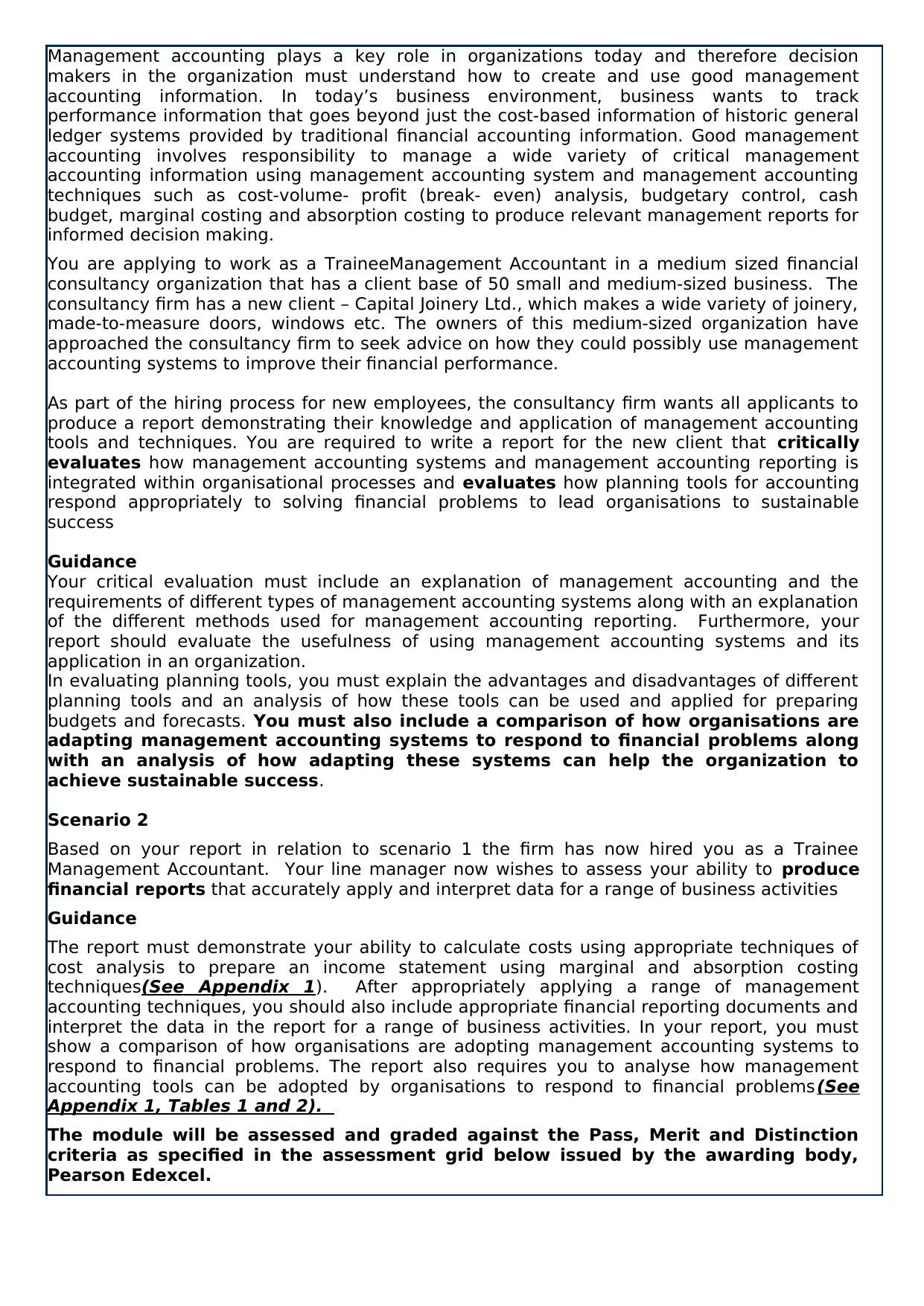
Management accounting plays a key role in organizations today and therefore decision
makers in the organization must understand how to create and use good management
accounting information. In today’s business environment, business wants to track
performance information that goes beyond just the cost-based information of historic general
ledger systems provided by traditional financial accounting information. Good management
accounting involves responsibility to manage a wide variety of critical management
accounting information using management accounting system and management accounting
techniques such as cost-volume- profit (break- even) analysis, budgetary control, cash
budget, marginal costing and absorption costing to produce relevant management reports for
informed decision making.
You are applying to work as a TraineeManagement Accountant in a medium sized financial
consultancy organization that has a client base of 50 small and medium-sized business. The
consultancy firm has a new client – Capital Joinery Ltd., which makes a wide variety of joinery,
made-to-measure doors, windows etc. The owners of this medium-sized organization have
approached the consultancy firm to seek advice on how they could possibly use management
accounting systems to improve their financial performance.
As part of the hiring process for new employees, the consultancy firm wants all applicants to
produce a report demonstrating their knowledge and application of management accounting
tools and techniques. You are required to write a report for the new client that critically
evaluates how management accounting systems and management accounting reporting is
integrated within organisational processes and evaluates how planning tools for accounting
respond appropriately to solving financial problems to lead organisations to sustainable
success
Guidance
Your critical evaluation must include an explanation of management accounting and the
requirements of different types of management accounting systems along with an explanation
of the different methods used for management accounting reporting. Furthermore, your
report should evaluate the usefulness of using management accounting systems and its
application in an organization.
In evaluating planning tools, you must explain the advantages and disadvantages of different
planning tools and an analysis of how these tools can be used and applied for preparing
budgets and forecasts. You must also include a comparison of how organisations are
adapting management accounting systems to respond to financial problems along
with an analysis of how adapting these systems can help the organization to
achieve sustainable success.
Scenario 2
Based on your report in relation to scenario 1 the firm has now hired you as a Trainee
Management Accountant. Your line manager now wishes to assess your ability to produce
financial reports that accurately apply and interpret data for a range of business activities
Guidance
The report must demonstrate your ability to calculate costs using appropriate techniques of
cost analysis to prepare an income statement using marginal and absorption costing
techniques(See Appendix 1). After appropriately applying a range of management
accounting techniques, you should also include appropriate financial reporting documents and
interpret the data in the report for a range of business activities. In your report, you must
show a comparison of how organisations are adopting management accounting systems to
respond to financial problems. The report also requires you to analyse how management
accounting tools can be adopted by organisations to respond to financial problems(See
Appendix 1, Tables 1 and 2).
The module will be assessed and graded against the Pass, Merit and Distinction
criteria as specified in the assessment grid below issued by the awarding body,
Pearson Edexcel.
makers in the organization must understand how to create and use good management
accounting information. In today’s business environment, business wants to track
performance information that goes beyond just the cost-based information of historic general
ledger systems provided by traditional financial accounting information. Good management
accounting involves responsibility to manage a wide variety of critical management
accounting information using management accounting system and management accounting
techniques such as cost-volume- profit (break- even) analysis, budgetary control, cash
budget, marginal costing and absorption costing to produce relevant management reports for
informed decision making.
You are applying to work as a TraineeManagement Accountant in a medium sized financial
consultancy organization that has a client base of 50 small and medium-sized business. The
consultancy firm has a new client – Capital Joinery Ltd., which makes a wide variety of joinery,
made-to-measure doors, windows etc. The owners of this medium-sized organization have
approached the consultancy firm to seek advice on how they could possibly use management
accounting systems to improve their financial performance.
As part of the hiring process for new employees, the consultancy firm wants all applicants to
produce a report demonstrating their knowledge and application of management accounting
tools and techniques. You are required to write a report for the new client that critically
evaluates how management accounting systems and management accounting reporting is
integrated within organisational processes and evaluates how planning tools for accounting
respond appropriately to solving financial problems to lead organisations to sustainable
success
Guidance
Your critical evaluation must include an explanation of management accounting and the
requirements of different types of management accounting systems along with an explanation
of the different methods used for management accounting reporting. Furthermore, your
report should evaluate the usefulness of using management accounting systems and its
application in an organization.
In evaluating planning tools, you must explain the advantages and disadvantages of different
planning tools and an analysis of how these tools can be used and applied for preparing
budgets and forecasts. You must also include a comparison of how organisations are
adapting management accounting systems to respond to financial problems along
with an analysis of how adapting these systems can help the organization to
achieve sustainable success.
Scenario 2
Based on your report in relation to scenario 1 the firm has now hired you as a Trainee
Management Accountant. Your line manager now wishes to assess your ability to produce
financial reports that accurately apply and interpret data for a range of business activities
Guidance
The report must demonstrate your ability to calculate costs using appropriate techniques of
cost analysis to prepare an income statement using marginal and absorption costing
techniques(See Appendix 1). After appropriately applying a range of management
accounting techniques, you should also include appropriate financial reporting documents and
interpret the data in the report for a range of business activities. In your report, you must
show a comparison of how organisations are adopting management accounting systems to
respond to financial problems. The report also requires you to analyse how management
accounting tools can be adopted by organisations to respond to financial problems(See
Appendix 1, Tables 1 and 2).
The module will be assessed and graded against the Pass, Merit and Distinction
criteria as specified in the assessment grid below issued by the awarding body,
Pearson Edexcel.
⊘ This is a preview!⊘
Do you want full access?
Subscribe today to unlock all pages.

Trusted by 1+ million students worldwide
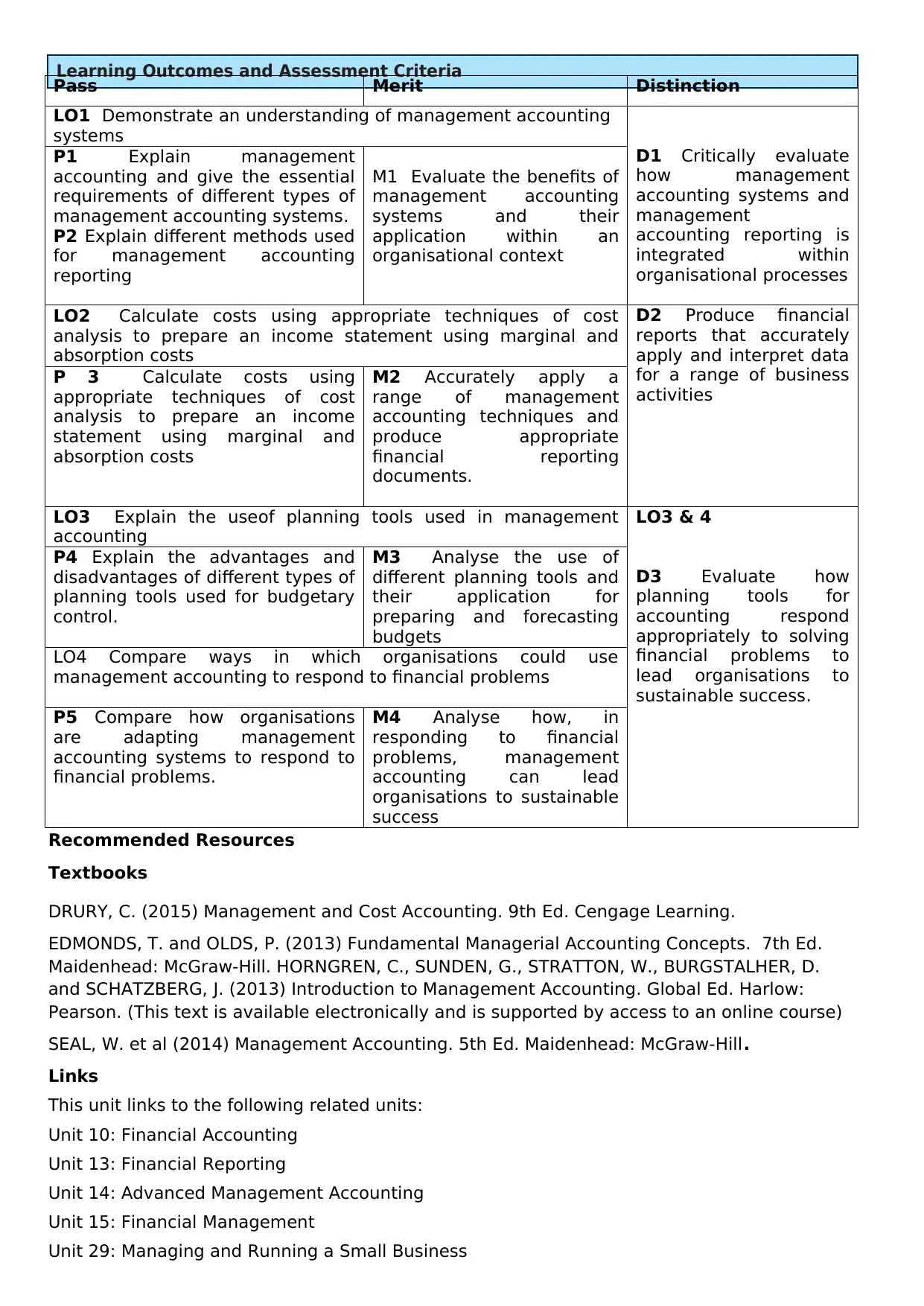
Recommended Resources
Textbooks
DRURY, C. (2015) Management and Cost Accounting. 9th Ed. Cengage Learning.
EDMONDS, T. and OLDS, P. (2013) Fundamental Managerial Accounting Concepts. 7th Ed.
Maidenhead: McGraw-Hill. HORNGREN, C., SUNDEN, G., STRATTON, W., BURGSTALHER, D.
and SCHATZBERG, J. (2013) Introduction to Management Accounting. Global Ed. Harlow:
Pearson. (This text is available electronically and is supported by access to an online course)
SEAL, W. et al (2014) Management Accounting. 5th Ed. Maidenhead: McGraw-Hill.
Links
This unit links to the following related units:
Unit 10: Financial Accounting
Unit 13: Financial Reporting
Unit 14: Advanced Management Accounting
Unit 15: Financial Management
Unit 29: Managing and Running a Small Business
Learning Outcomes and Assessment Criteria
Pass Merit Distinction
LO1 Demonstrate an understanding of management accounting
systems
D1 Critically evaluate
how management
accounting systems and
management
accounting reporting is
integrated within
organisational processes
P1 Explain management
accounting and give the essential
requirements of different types of
management accounting systems.
P2 Explain different methods used
for management accounting
reporting
M1 Evaluate the benefits of
management accounting
systems and their
application within an
organisational context
LO2 Calculate costs using appropriate techniques of cost
analysis to prepare an income statement using marginal and
absorption costs
D2 Produce financial
reports that accurately
apply and interpret data
for a range of business
activities
P 3 Calculate costs using
appropriate techniques of cost
analysis to prepare an income
statement using marginal and
absorption costs
M2 Accurately apply a
range of management
accounting techniques and
produce appropriate
financial reporting
documents.
LO3 Explain the useof planning tools used in management
accounting
LO3 & 4
D3 Evaluate how
planning tools for
accounting respond
appropriately to solving
financial problems to
lead organisations to
sustainable success.
P4 Explain the advantages and
disadvantages of different types of
planning tools used for budgetary
control.
M3 Analyse the use of
different planning tools and
their application for
preparing and forecasting
budgets
LO4 Compare ways in which organisations could use
management accounting to respond to financial problems
P5 Compare how organisations
are adapting management
accounting systems to respond to
financial problems.
M4 Analyse how, in
responding to financial
problems, management
accounting can lead
organisations to sustainable
success
Textbooks
DRURY, C. (2015) Management and Cost Accounting. 9th Ed. Cengage Learning.
EDMONDS, T. and OLDS, P. (2013) Fundamental Managerial Accounting Concepts. 7th Ed.
Maidenhead: McGraw-Hill. HORNGREN, C., SUNDEN, G., STRATTON, W., BURGSTALHER, D.
and SCHATZBERG, J. (2013) Introduction to Management Accounting. Global Ed. Harlow:
Pearson. (This text is available electronically and is supported by access to an online course)
SEAL, W. et al (2014) Management Accounting. 5th Ed. Maidenhead: McGraw-Hill.
Links
This unit links to the following related units:
Unit 10: Financial Accounting
Unit 13: Financial Reporting
Unit 14: Advanced Management Accounting
Unit 15: Financial Management
Unit 29: Managing and Running a Small Business
Learning Outcomes and Assessment Criteria
Pass Merit Distinction
LO1 Demonstrate an understanding of management accounting
systems
D1 Critically evaluate
how management
accounting systems and
management
accounting reporting is
integrated within
organisational processes
P1 Explain management
accounting and give the essential
requirements of different types of
management accounting systems.
P2 Explain different methods used
for management accounting
reporting
M1 Evaluate the benefits of
management accounting
systems and their
application within an
organisational context
LO2 Calculate costs using appropriate techniques of cost
analysis to prepare an income statement using marginal and
absorption costs
D2 Produce financial
reports that accurately
apply and interpret data
for a range of business
activities
P 3 Calculate costs using
appropriate techniques of cost
analysis to prepare an income
statement using marginal and
absorption costs
M2 Accurately apply a
range of management
accounting techniques and
produce appropriate
financial reporting
documents.
LO3 Explain the useof planning tools used in management
accounting
LO3 & 4
D3 Evaluate how
planning tools for
accounting respond
appropriately to solving
financial problems to
lead organisations to
sustainable success.
P4 Explain the advantages and
disadvantages of different types of
planning tools used for budgetary
control.
M3 Analyse the use of
different planning tools and
their application for
preparing and forecasting
budgets
LO4 Compare ways in which organisations could use
management accounting to respond to financial problems
P5 Compare how organisations
are adapting management
accounting systems to respond to
financial problems.
M4 Analyse how, in
responding to financial
problems, management
accounting can lead
organisations to sustainable
success
Paraphrase This Document
Need a fresh take? Get an instant paraphrase of this document with our AI Paraphraser
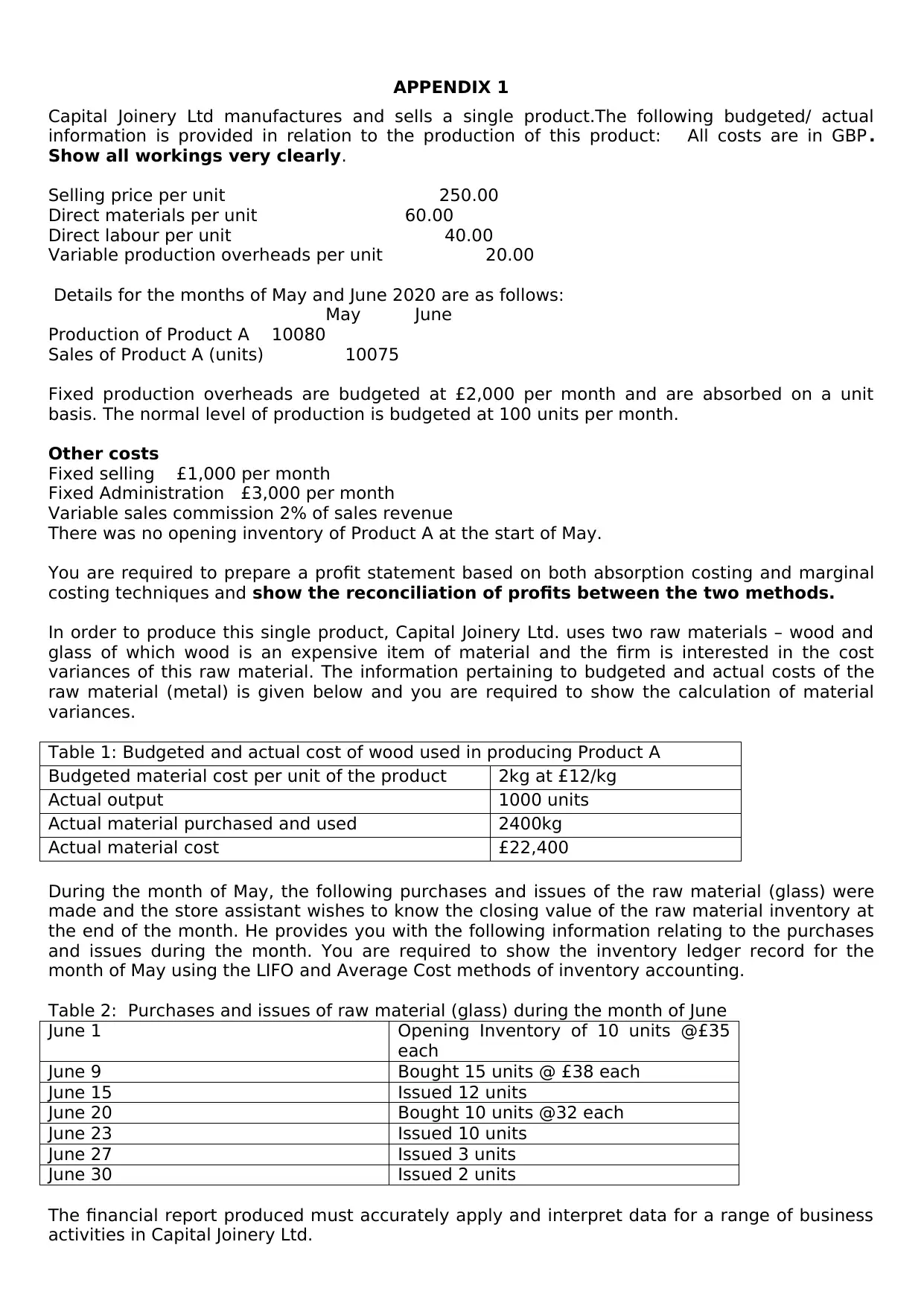
APPENDIX 1
Capital Joinery Ltd manufactures and sells a single product.The following budgeted/ actual
information is provided in relation to the production of this product: All costs are in GBP .
Show all workings very clearly.
Selling price per unit 250.00
Direct materials per unit 60.00
Direct labour per unit 40.00
Variable production overheads per unit 20.00
Details for the months of May and June 2020 are as follows:
May June
Production of Product A 10080
Sales of Product A (units) 10075
Fixed production overheads are budgeted at £2,000 per month and are absorbed on a unit
basis. The normal level of production is budgeted at 100 units per month.
Other costs
Fixed selling £1,000 per month
Fixed Administration £3,000 per month
Variable sales commission 2% of sales revenue
There was no opening inventory of Product A at the start of May.
You are required to prepare a profit statement based on both absorption costing and marginal
costing techniques and show the reconciliation of profits between the two methods.
In order to produce this single product, Capital Joinery Ltd. uses two raw materials – wood and
glass of which wood is an expensive item of material and the firm is interested in the cost
variances of this raw material. The information pertaining to budgeted and actual costs of the
raw material (metal) is given below and you are required to show the calculation of material
variances.
Table 1: Budgeted and actual cost of wood used in producing Product A
Budgeted material cost per unit of the product 2kg at £12/kg
Actual output 1000 units
Actual material purchased and used 2400kg
Actual material cost £22,400
During the month of May, the following purchases and issues of the raw material (glass) were
made and the store assistant wishes to know the closing value of the raw material inventory at
the end of the month. He provides you with the following information relating to the purchases
and issues during the month. You are required to show the inventory ledger record for the
month of May using the LIFO and Average Cost methods of inventory accounting.
Table 2: Purchases and issues of raw material (glass) during the month of June
June 1 Opening Inventory of 10 units @£35
each
June 9 Bought 15 units @ £38 each
June 15 Issued 12 units
June 20 Bought 10 units @32 each
June 23 Issued 10 units
June 27 Issued 3 units
June 30 Issued 2 units
The financial report produced must accurately apply and interpret data for a range of business
activities in Capital Joinery Ltd.
Capital Joinery Ltd manufactures and sells a single product.The following budgeted/ actual
information is provided in relation to the production of this product: All costs are in GBP .
Show all workings very clearly.
Selling price per unit 250.00
Direct materials per unit 60.00
Direct labour per unit 40.00
Variable production overheads per unit 20.00
Details for the months of May and June 2020 are as follows:
May June
Production of Product A 10080
Sales of Product A (units) 10075
Fixed production overheads are budgeted at £2,000 per month and are absorbed on a unit
basis. The normal level of production is budgeted at 100 units per month.
Other costs
Fixed selling £1,000 per month
Fixed Administration £3,000 per month
Variable sales commission 2% of sales revenue
There was no opening inventory of Product A at the start of May.
You are required to prepare a profit statement based on both absorption costing and marginal
costing techniques and show the reconciliation of profits between the two methods.
In order to produce this single product, Capital Joinery Ltd. uses two raw materials – wood and
glass of which wood is an expensive item of material and the firm is interested in the cost
variances of this raw material. The information pertaining to budgeted and actual costs of the
raw material (metal) is given below and you are required to show the calculation of material
variances.
Table 1: Budgeted and actual cost of wood used in producing Product A
Budgeted material cost per unit of the product 2kg at £12/kg
Actual output 1000 units
Actual material purchased and used 2400kg
Actual material cost £22,400
During the month of May, the following purchases and issues of the raw material (glass) were
made and the store assistant wishes to know the closing value of the raw material inventory at
the end of the month. He provides you with the following information relating to the purchases
and issues during the month. You are required to show the inventory ledger record for the
month of May using the LIFO and Average Cost methods of inventory accounting.
Table 2: Purchases and issues of raw material (glass) during the month of June
June 1 Opening Inventory of 10 units @£35
each
June 9 Bought 15 units @ £38 each
June 15 Issued 12 units
June 20 Bought 10 units @32 each
June 23 Issued 10 units
June 27 Issued 3 units
June 30 Issued 2 units
The financial report produced must accurately apply and interpret data for a range of business
activities in Capital Joinery Ltd.
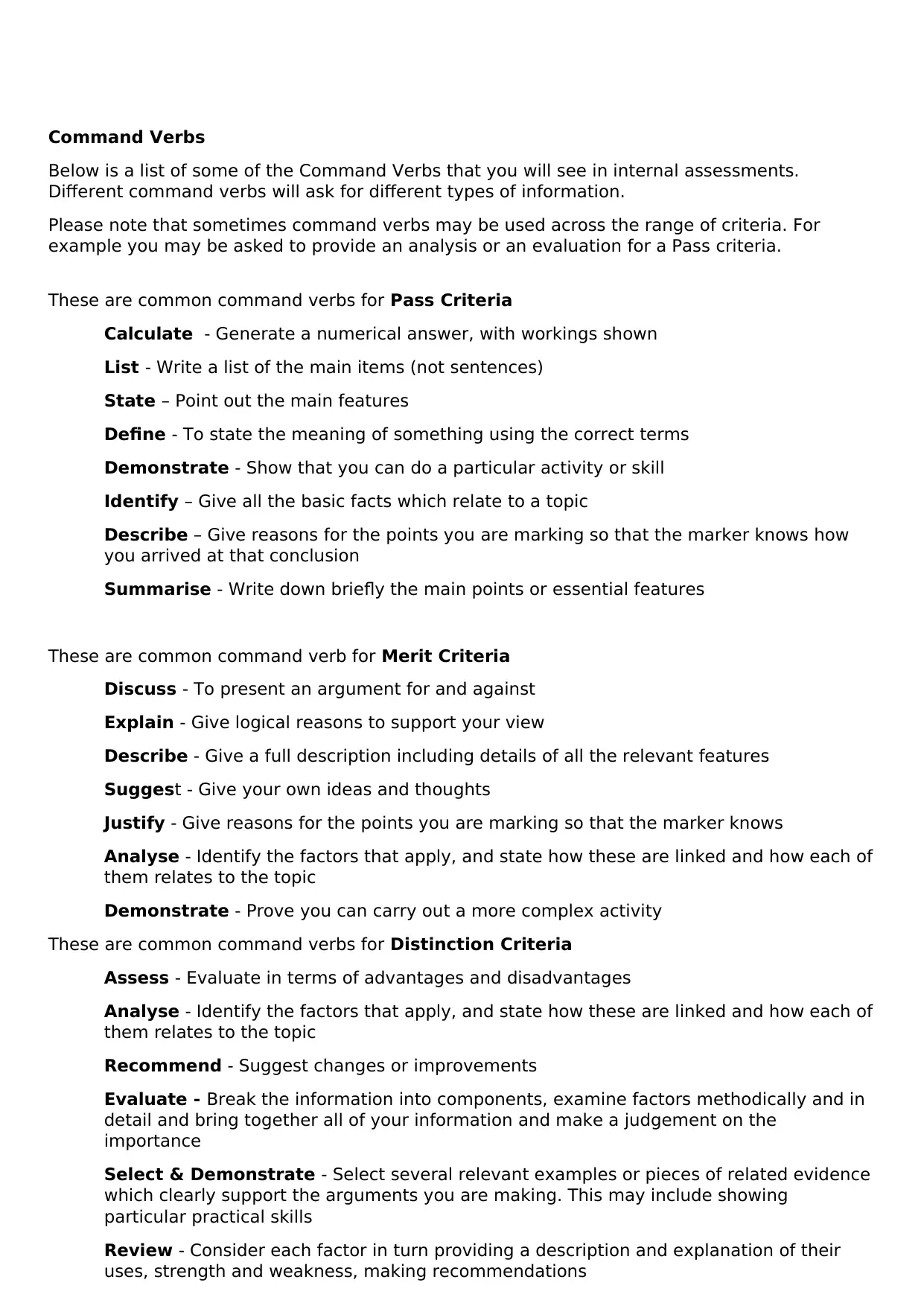
Command Verbs
Below is a list of some of the Command Verbs that you will see in internal assessments.
Different command verbs will ask for different types of information.
Please note that sometimes command verbs may be used across the range of criteria. For
example you may be asked to provide an analysis or an evaluation for a Pass criteria.
These are common command verbs for Pass Criteria
Calculate - Generate a numerical answer, with workings shown
List - Write a list of the main items (not sentences)
State – Point out the main features
Define - To state the meaning of something using the correct terms
Demonstrate - Show that you can do a particular activity or skill
Identify – Give all the basic facts which relate to a topic
Describe – Give reasons for the points you are marking so that the marker knows how
you arrived at that conclusion
Summarise - Write down briefly the main points or essential features
These are common command verb for Merit Criteria
Discuss - To present an argument for and against
Explain - Give logical reasons to support your view
Describe - Give a full description including details of all the relevant features
Suggest - Give your own ideas and thoughts
Justify - Give reasons for the points you are marking so that the marker knows
Analyse - Identify the factors that apply, and state how these are linked and how each of
them relates to the topic
Demonstrate - Prove you can carry out a more complex activity
These are common command verbs for Distinction Criteria
Assess - Evaluate in terms of advantages and disadvantages
Analyse - Identify the factors that apply, and state how these are linked and how each of
them relates to the topic
Recommend - Suggest changes or improvements
Evaluate - Break the information into components, examine factors methodically and in
detail and bring together all of your information and make a judgement on the
importance
Select & Demonstrate - Select several relevant examples or pieces of related evidence
which clearly support the arguments you are making. This may include showing
particular practical skills
Review - Consider each factor in turn providing a description and explanation of their
uses, strength and weakness, making recommendations
Below is a list of some of the Command Verbs that you will see in internal assessments.
Different command verbs will ask for different types of information.
Please note that sometimes command verbs may be used across the range of criteria. For
example you may be asked to provide an analysis or an evaluation for a Pass criteria.
These are common command verbs for Pass Criteria
Calculate - Generate a numerical answer, with workings shown
List - Write a list of the main items (not sentences)
State – Point out the main features
Define - To state the meaning of something using the correct terms
Demonstrate - Show that you can do a particular activity or skill
Identify – Give all the basic facts which relate to a topic
Describe – Give reasons for the points you are marking so that the marker knows how
you arrived at that conclusion
Summarise - Write down briefly the main points or essential features
These are common command verb for Merit Criteria
Discuss - To present an argument for and against
Explain - Give logical reasons to support your view
Describe - Give a full description including details of all the relevant features
Suggest - Give your own ideas and thoughts
Justify - Give reasons for the points you are marking so that the marker knows
Analyse - Identify the factors that apply, and state how these are linked and how each of
them relates to the topic
Demonstrate - Prove you can carry out a more complex activity
These are common command verbs for Distinction Criteria
Assess - Evaluate in terms of advantages and disadvantages
Analyse - Identify the factors that apply, and state how these are linked and how each of
them relates to the topic
Recommend - Suggest changes or improvements
Evaluate - Break the information into components, examine factors methodically and in
detail and bring together all of your information and make a judgement on the
importance
Select & Demonstrate - Select several relevant examples or pieces of related evidence
which clearly support the arguments you are making. This may include showing
particular practical skills
Review - Consider each factor in turn providing a description and explanation of their
uses, strength and weakness, making recommendations
⊘ This is a preview!⊘
Do you want full access?
Subscribe today to unlock all pages.

Trusted by 1+ million students worldwide

1 out of 7
Related Documents
Your All-in-One AI-Powered Toolkit for Academic Success.
+13062052269
info@desklib.com
Available 24*7 on WhatsApp / Email
![[object Object]](/_next/static/media/star-bottom.7253800d.svg)
Unlock your academic potential
Copyright © 2020–2025 A2Z Services. All Rights Reserved. Developed and managed by ZUCOL.





